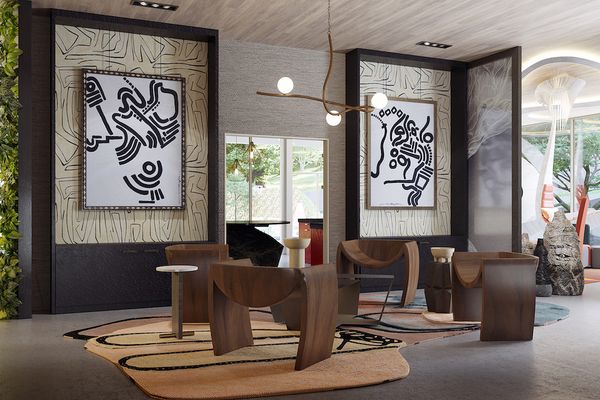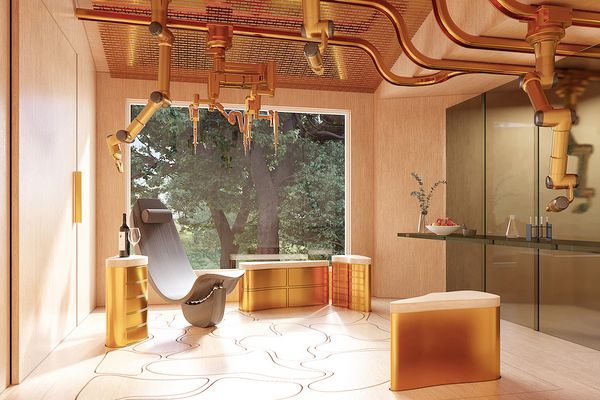The Artist Studios & Garden, I am Good Enough, A Haven for the Black Overachiever by Linda Allen Designs.
Exploring Obsidian Virtual Concept House for the first time, the adjectives that initially come to mind are mostly intangible: luminescent, warm, welcoming. Around the space, there is a squiggly line to offset each straight one, gold that catches up with orange, leafy trees visible through the wrap-around windows—and light gleaming from unexpected places. Capturing a transportive serenity even in its virtual staging, Obsidian envisions not a house but a future, a way of being.
The project, the inaugural initiative of Black Artists + Designers Guild (BADG), was designed by 23 BADG creators and two Rising Stars driven by four core tenets: Innovation, Technology, Sustainability, and Futurism; as well as seven fundamentals: Wellness, Identity, Sustenance, Terra, Legacy, Ancestral Futures, and Dwelling. All with the ambition to redress environmental injustice and promote Black innovation and insight. Obsidian is a virtual dwelling imagined in California's Oakland Hills in the year 2025; the project will have five iterations over the coming years.

The Barka Dai, An Abundance of Welcome by Cheryl Umbles Interior Design.
For some designers, this opportunity—on this scale—was entirely new. “I’ve never worked on a project like this,” commented Nina Cooke John of Studio Cooke John. Even though she has worked with BADG members before, Obsidian strengthened her belief in what BADG "does for us both in terms of not only resources but a community of artists and designers that are working towards the same goal but in very different ways.” Leyden Lewis of Leyden Lewis Design Studio described a similar experience: “I’ve done work for people of color and specifically Black people. But this is special.”
In order to start this project, Lewis says there was one question that motivated his work: “When Black people dream what do they dream about?” The query seeped into the programming, layout, and details of the house, which fuses a plurality of experiences. Lewis continues, “It is a collage of personal and collective memories we each share as peoples from the Caribbean. With that, the design richly echoes and reflects each of our present family structures.”

The Room of Requirement by Leyden Lewis Design Studio.
In practice, the space was thought about deeply—and in relation to the times we live in. Everick Brown of Everick Brown Design explains that living in a pandemic prompted the designers to craft a Glam Room for hairstyling, as well as a “transitional space to cleanse before entering the house.” The spaces are meant to be multipurpose (one is even called “The Room of Requirement”), reflecting the way rooms, especially right now, adapt to the people who use them.
The designers challenged not just an architectural vocabulary, but also the way we name and talk about spaces. The rooms have original names, like a “Soul Center” for lounging and “The Atlantic” for swimming. As Kelly Finley of Joy Street Design notes, “Instead of relying on traditional Western titles for the spaces, the Obsidian committee instead wanted the focus to be on the use of the room and the particular feeling.” The renaming is an opportunity for mindfulness, to step into and greet each space with intention.

The Wellness Studio by Kiyonda Powell Design.
The concepts around Obsidian also take into account the fact that our moment is a cumulative one; our present represents the most recent climax of systemic injustices against Black communities. BADG and Obsidian together offer a model designed for Black families to thrive. “We are Black people and we’ve lived the Black experience,” explains Nina Cooke John. “During our design process we talked about issues that are current, and related to us and related to the Black community now but also historic issues that affect how we live as a family, how we live as a community, or historical precedent.”
“These spaces are for us and, in so defining, honor our histories and futures,” adds Malene Barnett, the Founder of BADG, “Obsidian documents our aspirations and celebrates how we, as Black creators, can dream our communities into life.”

Recommended Reading
Hernan Bas, Oscar Wilde, and the Great Outdoors >
How Genieve Figgis Inspired ‘Bridgerton’ >
